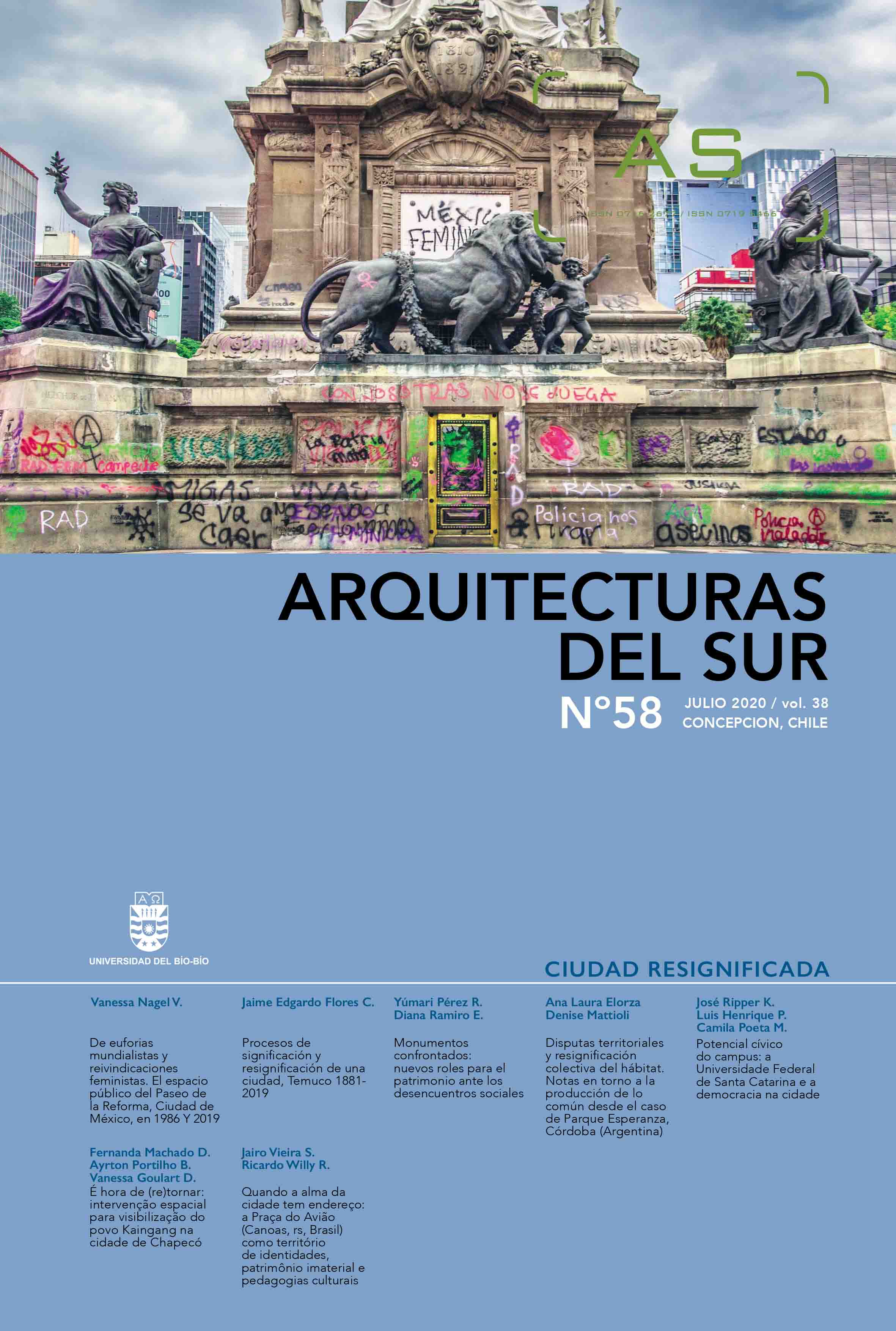It’s time to (re)define: Spatial intervention to make the Kaingang visible in the city of Chapecó
DOI:
https://doi.org/10.22320/07196466.2020.38.058.06Keywords:
kaingang culture, cultural identity, urban intervention, city history, free space systemAbstract
The Kaingang indigenous population has inhabited the space that comprises the heart of the municipality of Chapecó-SC, State of Santa Catarina in Southern Brazil, since before the formal foundation of the city. However, due to the urbanization process, this community has seen its history and relationship with the city made invisible by actions, originating mainly from the government. In order to contribute to the transformation of this context, a system of free spaces for intercultural dialogues was prepared collaboratively with the indigenous community, which proposes to tell the history of the city from the perspective of its traditional people and to redefine urban public spaces through spatial interventions at different scales. The methodological strategies adopted include bibliographic research, exploratory visits, oral history reports, a poem of wishes and participant observation, valuing the role of the Kaingang community in the design process. This paper presents the results of this project and highlights the possibilities for historical and cultural valorization through urban interventions. It is believed that spatial actions can re-signify both the places and the human interactions resulting from the experience of these spaces.
Downloads
References
CAMPOS, S. (2004). A voz de Chapecó: Artigo de Antonio Selistre de Campos - 1939- 1952. Centro de Memória do Oeste Catarinense (org). Argos, Chapecó, Brasil.
DILL, F. M. (2019). Linguagem Socioespacial: A dimensão espacial do modo de viver Kaingang. (Tese de doutorado) Universidade Federal de Santa Catarina, Brasil.
GIDDENS, A. (2002). Modernidade e identidade. Zahar, Rio de Janeiro, Brasil.
IBGE. (2010). Características gerais dos indígenas: Resultados do Universo. Ministério do Planejamento, Orçamento e Gestão. Rio de Janeiro, Brasil.
JUNIOR, A. G. (2010). Estudo Etnográfico sobre Alcoolização entre os Índios Kaingang da Terra Indígena Xapecó: das Dimensões Construtivas à Perturbação. (Dissertação de mestrado) Universidade Federal de Santa Catarina, Brasil.
KRESÓ, P. (1997). O Kiki permanece. In: EG JAMEN KY MU - textos KAINGÁG. TORAL, A. 80-87. APBKG/MEC/PNUD, Brasília, Brasil.
KUPER, A. (2002). Cultura, diferença, identidade. Em A. KUPER, Cultura: a visão dos antropólogos. Tradução Mirtes Frange de Oliveira Pinheiros (pp. pp.287-318). EDUSC, Bauru, Brasil.
MAGNOLI, M. (2006). Em Busca de “Outros” Espaços Livres de Edificação. Revista Paisagem Ambiente: Ensaios, no. 21. p. 141 a 174, São Paulo, Brasil
MANN, P. H. (1970). Métodos de investigação sociológica. Zahar, Rio de Janeiro, Brasil.
MEIHY, J. C. (1996). Manual de História Oral. Edições Loyola, São Paulo, Brasil.
PROSHANSKY, H. M. (1993). Place identity: Physical world socialization of the self. Journal of Environmental Psychology.
RAPOPORT, A. (1971). Hechos y Modelos. Em G. BROADBENT, Metodologia del Diseño Arquitectónico (pp. p. 297-323). Editorial Gustavo Gili, Barcelona, Espanha.
SANOF, H. (1994). School Design. John Wiley e Sons INC, New York, EUA.
TOMMASINO, K., Capucci, J.M.R. e Cabral Jr., V.A. (1999). Relatório II: Eleição de área para os Kaingang da Aldeia Kondá. FUNAI, Chapecó, Brasil.
TOMMASINO, K. et. al. (1998). Relatório I: Eleição de área para os Kaingang da Aldeia Kondá. FUNAI, Chapecó, Brasil.
TOMMASINO, K., R. C. FERNANDES. (2001). Povos indígenas no Brasil. Educ, São Paulo, Brasil.
TUAN, Y. F. (1983). Espaço e Lugar: a perspectiva da experiência. Difel, São Paulo, Brasil.
TYLOR, E. (1958). Primitive Culture. John Mursay & Co, Londres, Inglaterra.
UNWIN, S. (2013). A análise da arquitetura. Tradução técnica: Alexandre Salvaterra. Bookman, Porto Alegre, Brasil.
ZANIN, N. Z., e DILL, F. M. (2016). Educação escolar indígena manifestada em intervenção arquitetônica: reflexões a partir de uma escola Kaingang. Anais do XVI Encontro Estadual de História da ANPUH-SC, Brasil.
Downloads
Published
How to Cite
Issue
Section
License
Copyright (c) 2020 Fernanda Machado Dill, Ayrton Portilho Bueno, Vanessa Goulart Dorneles

This work is licensed under a Creative Commons Attribution-ShareAlike 4.0 International License.
The content of the articles published in each issue of Arquitecturas del Sur is the sole responsibility of the authors and does not necessarily represent the opinion of University of the Bío-Bío.
The authors will maintain their copyright; however, they will guarantee the journal the right to first publication and dissemination of their work. The publication of the article in Arquitecturas del Sur will be subject to the Creative Commons International license (CC BY-SA) that allows others to adapt: remix, transform and build on the material for any purpose, even commercially; share: copy and redistribute the material in any medium or format, as long as the authorship and first publication in this journal are acknowledged by citing them correctly, and their new contributions are under a license with the same terms.














 Programa de Información Científica/Concurso Fondos de Publicación de Revistas Científicas 2018/ Proyecto Mejoramiento de Visibilidad de Revistas UBB (Código:FP180007)
Programa de Información Científica/Concurso Fondos de Publicación de Revistas Científicas 2018/ Proyecto Mejoramiento de Visibilidad de Revistas UBB (Código:FP180007) 
